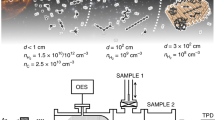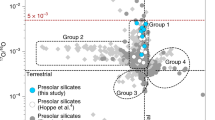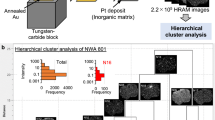Abstract
AN important discovery made by the 1986 spacecraft encounters with comet Halley was that of 'CHON particles', dust that is predominantly composed of the light elements carbon, hydrogen, oxygen and nitrogen1–3. Using three sets of particle mass spectra that were critically selected for high dynamic range and a minimum of defects, we investigate here the relationship between CHON and silicate materials. We find that there are essentially no pure CHON particles in the 0.1–1 µm size range sampled; instead, essentially all Halley particles sampled by the mass spectrometers are a mixture of both CHON and silicate components. The earlier evidence for pure CHON particles1,4,5 came from mass spectra with low dynamic range, in which only the highest major-element peaks could be detected. Our data show that the CHON and silicate components are interdispersed at submicrometre scales, and there is evidence that sublimation of volatile organic material occurs, bringing many particles to a common proportion of CHON and silicate material.
This is a preview of subscription content, access via your institution
Access options
Subscribe to this journal
Receive 51 print issues and online access
$199.00 per year
only $3.90 per issue
Buy this article
- Purchase on Springer Link
- Instant access to full article PDF
Prices may be subject to local taxes which are calculated during checkout
Similar content being viewed by others
References
Clark, B., Mason, L. W. & Kissel, J. in Proc. 20th ESLAB Symp. Exploration of Halley's Comet, Eur. Space Ag. spec. Publ. 250, Vol. III 353–358 (1986); Astr. Astrophys. 187, 779–784 (1987).
Kissel, J. et al. Nature 321, 280–282 (1986).
Kissel, J. et al. Nature 321, 336–337 (1986).
Delsemme, A. H. in Comets in the Post-Halley Era, Vol. 1 377–428 (Kluwer, Dordrecht, 1991).
A'Hearn, M. et al. Nature 324, 649–651 (1986).
Kissel, J. in Eur. Space Ag. spec. Publ. 1077, 67–83 (1986).
Langevin, Y., Kissel, J., Bertaux, J.-L. & Chassefiere, E. in Lunar planet. Sci. XVIII, 533–134 (1987).
Langevin, Y., Kissel, J., Bertaux, J.-L. & Chassefiere, E. Astr. Astrophys. 187, 761–766 (1987).
Lawler, M. E., Brownlee, D. E., Temple, S. & Wheelock, M. M. Icarus 80, 225–242 (1989).
Jessberger, E. K., Christoforidis, A. & Kissel, J. Nature 332, 691–695 (1988).
Mukhin, L. M. et al. Nature 350, 480–481 (1991).
Maas, D., Krueger, F. R. & Kissel, J. in Asteroids, Comets, and Meteors III (eds Lagervist, C.-I. et al.) (Reprocentralen HSC, Uppsala, 1990).
Sole, M., Jessberger, E. K., Hsiung, P. & Kissel, J. Science 67, 47–50 (1987).
Geiss, J. Astr. Astrophys. 187, 859–866 (1987).
Jessberger, E. K. & Kissel, J. in Comets in the Post-Halley Era, Vol. 2, 1075–1092 (Kluwer, Dordrecht, 1991).
Brownlee, D. E., Wheelock, M. M., Temple, S., Bradley, J. P. & Kissel, J. Lunar planet. Sci. XVIII, 133–134 (1987).
Mukhin, L. M. et al. Lunar planet. Sci. XVIII, 674–675 (1987).
Sagdeev, R. Z. et al. Cosmic Res. 25, 655–662 (1988).
McDonnell, J. A. M., Lamy, P. L. & Pankiewicz, G. S. in Comets in the Post-Halley Era, Vol. 2, 1043–1073 (Kluwer, Dordrecht, 1991).
Brownlee, D. E. Rev. Earth planet. Sci. 13, 147–173 (1985).
Bradley, J. P. Geochim cosmochim. Acta 52, 889–900 (1988).
Rietmeijer, F. J. M. in Proc. 19th Lunar planet. Sci. Conf. 513–521 (1989).
Bregman, J. D. et al. Astr. Astrophys. 187, 616–620 (1987).
Greenberg, J. M. in Comet Halley: Investigations, Results, Interpretations, Vol. 2 (ed. Mason, J. W.) (Ellis Horwood, London, 1990)
Kissel, J. & Krueger, F. R. Nature 326, 755–760 (1987).
Eberhardt, P. et al. Astr. Astrophys. 187, 481–484 (1987).
Krankowsky, D. in Comets in the Post-Halley Era, Vol. 2, 855–877 (Kluwer, Dordrecht, 1992).
Jewitt, D. in Comets in the Post-Halley Era, Vol. 1, 19–65 (Kluwer, Dordrecht, 1991).
A'Hearn, M. et al. in Proc. 20th ESLAB Symp. Exploration of Halley's Comet, Eur. Space Ag. spec. Publ. 250, Vol. 1, 483–486 (1986).
Mukai, T., Fechtig, H., Grün, E. & Giese, R. H. Icarus 80, 254–266 (1989).
Lichtenegger, H. I. M. & Kömle, N. I. Icarus 90, 319–325 (1991).
Author information
Authors and Affiliations
Rights and permissions
About this article
Cite this article
Lawler, M., Brownlee, D. CHON as a component of dust from comet Halley. Nature 359, 810–812 (1992). https://doi.org/10.1038/359810a0
Received:
Accepted:
Issue Date:
DOI: https://doi.org/10.1038/359810a0
Comments
By submitting a comment you agree to abide by our Terms and Community Guidelines. If you find something abusive or that does not comply with our terms or guidelines please flag it as inappropriate.



